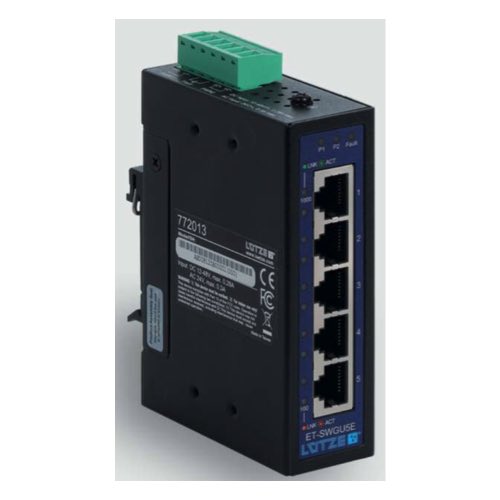Lutze Ethernet Switches

Lutze Ethernet switches were built to give reliable, fast networking for industrial automation. Built for the tough demands of modern control setups, these switches keep the connection between PLCs, HMIs, sensors and other automation parts, for steady communication.
Lutze Ethernet switches offer unmanaged models which are plug‑and‑play; they’re perfect for small or isolated setups. Each model is constructed to withstand temperature fluctuations, vibration, and electrical interference, ensuring reliable performance even in harsh conditions.
Lutze’s Ethernet switches have built‑in test tools and flashing LEDs that let you spot a problem and fix it.These switches are built for DIN rail mounting and compact panel use, so you can install them in cramped control cabinets without any hassle. They support fast Ethernet and gigabit links; enough bandwidth for real‑time control and data capture.
FAQs
Q: What types of Ethernet switches does Lutze offer?
Lutze primarily offers unmanaged Ethernet switches in the E-CO series. These switches provide plug-and-play connectivity without the need for network configuration.
Q: How do Lutze Ethernet switches fit into an industrial network?
Lutze Ethernet switches help segment industrial networks, provide dedicated bandwidth per port, and improve communication performance compared to legacy bus-based systems.
Q: What port counts and speeds are available for Lutze Ethernet switches?
Lutze offers unmanaged switches with 5, 8, or 16 ports supporting 10/100 Mb/s speeds, with some models offering Gigabit (1000 Mb/s) connectivity.
Q: Do Lutze Ethernet switches support redundant power or wide input voltage?
Some Lutze switch models support redundant power inputs and wide DC voltage ranges, typically 12–48 V DC, providing flexibility for industrial power systems.
Q: How do I choose the right Lutze Ethernet switch for my application?
Selection depends on required port count, network speed, installation environment, input voltage, available cabinet space, and whether unmanaged operation meets the application’s needs.
Why Buy Lutze Ethernet Switches from RSP Supply
RSP Supply offers a reliable selection of Lutze Ethernet switches for industrial automation and control applications. Customers rely on RSP Supply for access to trusted industrial networking brands, detailed technical product information, and knowledgeable support to help ensure proper network design and long-term system reliability.

